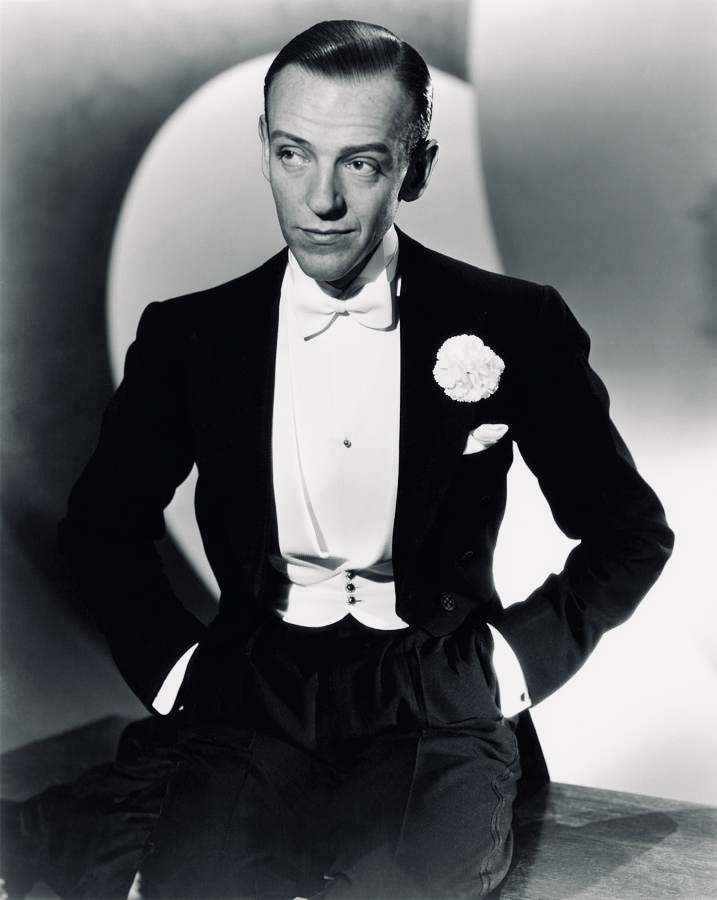
Despite the best intentions of our Founding Fathers, Americans have long been crazy for aristocrats — particularly when it comes to emulating their style.
In the 1930s, fashionable men looked to a pair of princes for their cues. One, the Prince of Wales, aka the Duke of Windsor, was a bona fide blueblood, and the influence of his Fair Isle sweaters, midnight-blue dinner jackets, and country-house suits was reflected in the gentlemanly swank of Esquire’s fashion illustrations and in the haberdasheries that catered to the well heeled.
When he foxtrotted off with that divorcé from Baltimore, the dapper Prince abdicated more than an imperial throne. He passed the title of ranking monarch of male fashion to a royal from another powerful, if slightly more mythical, land: Hollywood. Fred Astaire’s reign would prove to be a long one, and his enduring imprint on American style is a legacy as remarkable as his films.
While most of us have happily been content to sit back and watch the man dance, Astaire has long been a magnet for cultural historians, and Joseph Epstein, former editor of The American Scholar, stepped up for his turn on the floor last year with his brief biography, “Fred Astaire” (Yale University Press). The book wasn’t exactly rapturously received (the New York Observer pronounced it “intellectual slumming” and “priggish”), and an extended excerpt in the Hudson Review shows that the carping is justified.
In it, Epstein comes off as alternately snarky, sour, and worst, clueless about musicals — as expected for a highbrow whose works include a volume called “Snobbery.” He’s also not been done any favors by his copy editor. Among other gaffes, he manages to misspell the name of one of Fred’s frequent co-stars, Helen Broderick, and refer to Van Nest Polglase, RKO’s master of the 1930s Big White Set, as an exemplar of Art Nouveau, and mangle his name as well. Epstein’s biggest head-scratcher, though, is his assertion that for all the pure joy that Astaire radiated to generations of audiences, he falls short of being a genius. Instead he’s an undeniably talented, perfection-obsessed, but basically dull fellow who can somehow dance up a storm.
As Miss Broderick might dryly retort with an appropriate eye roll, “Oh, yeah?”
For all his ivory-tower bloviating, Epstein manages to score a few salient points about the foundation of Astaire’s stardom, with insights that apply to both his on-screen personality and his off-screen wardrobe. “Charm is elegance made casual, with emphasis on the casual,” he comments, later noting that “American charm, to be truly American, somehow has to combine the aristocratic with the democratic, but without a trace of snobbery.”
Astaire’s fashion sensibility embodies that “elegance made casual” dictum. Though he spent plenty of screen time wearing duded-up shirtfronts and white tie, as the title song from “Top Hat” goes, it’s in the area of less formal clothing that his legacy can clearly be seen. His enduring achievement was to take the elements of traditional menswear — the day suits and sportswear and accessories — and apply an artist’s eye to their interpretation. Literally tailored to his own personality and his requirements as a dancer, Astaire developed a look that was comfortable, contemporary, and to crib another phrase from Irving Berlin, “simply reeks of class.” But, like the man himself, that class was manifested in a very approachable and very American sense of the term.
The up-and-coming Astaire had always been a fan of fine clothing and was a Brooks Brothers customer since his teens. His stage sojourns in 1920s London introduced him to the polished luxury of Savile Row and brought him into the social set of the Prince of Wales and his brothers, where he got a close look at how the bespoke style was carried off by the folks who invented it.
A story in his autobiography, “Steps in Time,” shows that Astaire’s eye for fashion was always on the alert. After a sports car collided with his Rolls-Royce Twenty on Grosvenor Square, all he could focus on was the diamond-and-ruby studs and waistcoat buttons of the evening-dressed driver who emerged from the other car. The next day the Rolls went into the shop, and Fred went to Cartier for his own set.
Just as he combined the traditions of vaudeville tap, ballroom, and show dancing into a signature modern mix, Astaire worked his personal magic on his version of the London menswear he grew to admire. Jeweled evening sets notwithstanding, he focused on bringing a more relaxed American swagger to the British accent that now influenced his wardrobe. Over the years his style struck a delicately measured sartorial balance among Jermyn Street, Broadway, and Mulholland Drive.
To accomplish it, Astaire chose supple weights of fabric to enhance the drape of his soft-shouldered suits, cuts that hewed more closely to his slim torso, and armholes that were inset higher on his jackets to offer the wider range of motion that a dancer’s body demanded. Side vents and hacking pockets were features of his checked jackets. A striped, double-breasted banker’s suit might get a looser kick from being teamed with suede shoes, and colored socks could downplay the formality of any ensemble. An old anecdote describes him throwing his jackets against the wall after picking them up from the tailor, “just to show them who’s boss.” For all its showbiz flair and transatlantic sheen, Astaire certainly never let his clothing dominate him.
As spectacular as each was, Fred Astaire and his wardrobe managed to seem both effortless and understated. That’s one definition of genius. And that’s why he rightly holds a special place in the fashion pantheon. Like the composers whose songs he sang, Astaire had the taste and smarts to stick to the classics. Buttondown shirts, repp ties, British tweeds, and gray flannels were lifelong staples of his lived-in look, as appealing and appropriate on a fresh-to-movies Fred as they would be during his elder statesman years.
Astaire’s genius as a dancer is rooted in the fact that he made the nigh-impossible look easy. When the lights went up after one of his films, men did their approximation of the Continental, the Yam, or the Shorty George up the theater aisles and into the street because his performances convinced them that they could.
His inspiration also made men feel that dressing elegantly but casually (and vice versa) could be equally a cinch. The most generous part of Fred Astaire’s genius remains rooted in the fact that that achievement — unlike his dancing — is one that still remains within our reach. All we have to do is follow his lead. — ROBERT SACHELI

Another example of elegance in print from the master of elegance himself…
I’m blushing, Michael.
And Barima, thanks for the nice words. The great thing about Astaire is that there’s so much to talk about when looking at his style as a both star and fashion influence.
Next month marks the 75th anniversary of the release of “Gay Divorcee”, his first star partnering with Ginger Rodgers. Start rehearsing The Continental, gents.
Umm, make that “Rogers”. There goes my cred as an Astaireophile.
Thank you for yet another great read.
hands down the most elegant of them all.when you’ve got it you’ve got it.